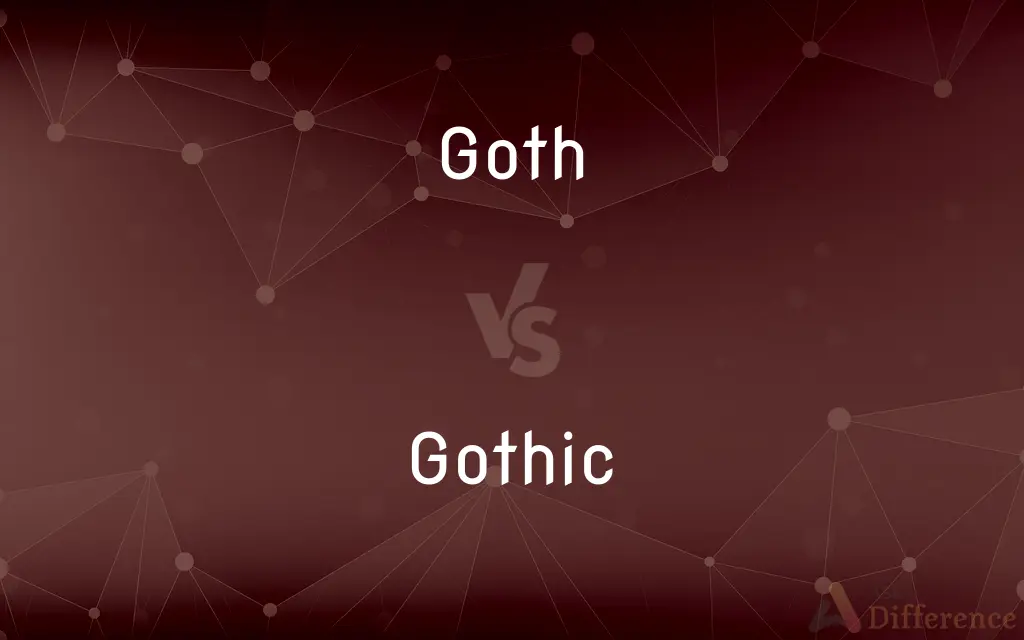Goth vs. Gothic — What's the Difference?
Edited by Tayyaba Rehman — By Urooj Arif — Updated on March 28, 2024
Goth refers to a subculture characterized by dark, mysterious fashion and music, while Gothic pertains to an architectural style from the Middle Ages or a genre of literature featuring horror and romance.

Difference Between Goth and Gothic
Table of Contents
ADVERTISEMENT
Key Differences
Goth is a modern subculture that emerged in the late 20th century, closely associated with specific genres of music like post-punk and gothic rock, and a distinct fashion style featuring dark clothing, makeup, and hair. This culture emphasizes themes of melancholy, beauty in darkness, and individualism. Gothic, on the other hand, originally describes a style of architecture known for its pointed arches, ribbed vaults, and flying buttresses, prevalent during the Middle Ages. Additionally, Gothic also refers to a literary genre that combines elements of horror, death, and at times, romance, characterized by its dark, eerie settings and moody atmospheres.
While Goth subculture can draw inspiration from Gothic literature, emphasizing similar themes of darkness and mystery, it is distinct in its manifestation as a contemporary social group with unique fashion, music, and artistic preferences. Conversely, the term Gothic encompasses a broader range of historical, architectural, and cultural elements, not limited to but including the macabre and supernatural themes found in Gothic literature and films.
The fashion and aesthetic of the Goth subculture often incorporate symbols and elements associated with death, the supernatural, and the Victorian era, blending modern and historical influences to create a unique identity. Gothic architecture, while also embracing the theme of the sublime and the transcendent, does so through structural grandeur and intricate design, aiming to evoke awe and spirituality.
Culturally, the Goth subculture provides a sense of community and identity for its members, often through music, clubs, and online forums, where as Gothic architecture and literature reflect the artistic and philosophical trends of their respective periods, influencing subsequent generations in terms of design, storytelling, and thematic exploration.
Comparison Chart
Origin
Late 20th century
Middle Ages (architecture); 18th century (literature)
ADVERTISEMENT
Key Elements
Dark fashion, gothic rock music, emphasis on melancholy and individualism
Pointed arches, ribbed vaults (architecture); horror, romance, dark settings (literature)
Cultural Significance
Expresses unique identity and community belonging through music and fashion
Reflects the artistic, philosophical, and cultural trends of the Middle Ages and later periods
Themes
Darkness, beauty in the macabre, individualism
The sublime, the supernatural, exploration of human emotion
Influences
Punk movement, Gothic literature
Romanesque architecture, Enlightenment and Romanticism (literature)
Compare with Definitions
Goth
The music associated with the Goth subculture.
Gothic rock bands like Bauhaus and Siouxsie and the Banshees are staples in the Goth community.
Gothic
A genre of literature that combines horror, death, and romance.
Dracula is a classic of Gothic literature, exploring themes of darkness and the supernatural.
Goth
A subculture characterized by dark aesthetics and music.
She felt most at home in the Goth scene, surrounded by others who shared her taste in music and fashion.
Gothic
Relating to an architectural style prevalent in the Middle Ages.
The cathedral is a prime example of Gothic architecture with its stunning pointed arches.
Goth
Themes of melancholy and the macabre in art and literature.
Her artwork is influenced by Goth aesthetics, featuring dark, eerie landscapes.
Gothic
Reflecting the historical period or aesthetic of the Goths.
The artifact dates back to the Gothic period, showing the artistic style of the time.
Goth
Pertaining to the fashion and style associated with the Goth subculture.
His Goth attire included black leather boots and a band t-shirt.
Gothic
The feeling of eeriness and the sublime in the natural world.
The Gothic beauty of the stormy sea captivated the painter.
Goth
Individuals who identify with the Goth subculture.
Goths often congregate at clubs that play their favorite gothic rock bands.
Gothic
Pertaining to the dark, mysterious elements in art and culture.
The movie's Gothic atmosphere added to its suspense.
Goth
A member of a Germanic people who invaded the Roman Empire in the early centuries of the Christian era.
Gothic
Of or relating to the Goths or their language.
Goth
A style of rock music, noted especially for somber or ethereal tones and lugubrious lyrics.
Gothic
Germanic; Teutonic.
Goth
A performer or follower of this style of music.
Gothic
Of or relating to the Middle Ages; medieval.
Goth
(uncountable) A punk-derived subculture of people who predominantly dress in black, associated with mournful music and attitudes.
Philip has been into goth for many years, haven't you dear?
Gothic
Of or relating to an architectural style prevalent in western Europe from the 12th through the 15th century and characterized by pointed arches, rib vaulting, and an emphasis on verticality and the impression of height.
Goth
A style of punk rock influenced by glam rock; gothic rock.
Gothic
Of or relating to an architectural style derived from medieval Gothic.
Goth
(countable) A person who is part of the goth subculture.
We saw a solitary goth hanging out on a ledge by the train station.
Gothic
Of or relating to painting, sculpture, or other art forms prevalent in northern Europe from the 12th through the 15th century.
Goth
Relating to goth music or people.
With her black clothes and dyed hair, Melanie looked very goth compared to her classmates.
Gothic
Often gothic Of or relating to a style of fiction that emphasizes the grotesque, mysterious, and desolate.
Goth
One of an ancient Teutonic race, who dwelt between the Elbe and the Vistula in the early part of the Christian era, and who overran and took an important part in subverting the Roman empire.
Gothic
Gothic Barbarous; crude.
Goth
One who is rude or uncivilized; a barbarian; a rude, ignorant person.
Gothic
The extinct East Germanic language of the Goths.
Goth
A crude uncouth ill-bred person lacking culture or refinement
Gothic
Gothic art or architecture.
Goth
One of the Teutonic people who invaded the Roman Empire in the 3rd to 5th centuries
Gothic
See black letter.
Gothic
See sans serif.
Gothic
A novel in a style emphasizing the grotesque, mysterious, and desolate.
Gothic
Alternative case form of Gothic
Gothic
Pertaining to the Goths; as, Gothic customs; also, rude; barbarous.
Gothic
Of or pertaining to a style of architecture with pointed arches, steep roofs, windows large in proportion to the wall spaces, and, generally, great height in proportion to the other dimensions - prevalent in Western Europe from about 1200 to 1475 a. d. See Illust. of Abacus, and Capital.
Gothic
The language of the Goths; especially, the language of that part of the Visigoths who settled in Moesia in the 4th century. See Goth.
Gothic
A kind of square-cut type, with no hair lines.
Gothic
Extinct East Germanic language of the ancient Goths; the only surviving record being fragments of a 4th-century translation of the Bible by Bishop Ulfilas
Gothic
A heavy typeface in use from 15th to 18th centuries
Gothic
A style of architecture developed in northern France that spread throughout Europe between the 12th and 16th centuries; characterized by slender vertical piers and counterbalancing buttresses and by vaulting and pointed arches
Gothic
Characteristic of the style of type commonly used for printing German
Gothic
Of or relating to the language of the ancient Goths;
The Gothic Bible translation
Gothic
Of or relating to the Goths;
Gothic migrations
Gothic
As if belonging to the Middle Ages; old-fashioned and unenlightened;
A medieval attitude toward dating
Gothic
Characterized by gloom and mystery and the grotesque;
Gothic novels like `Frankenstein'
Common Curiosities
How do modern Goths express their subculture?
Modern Goths express their subculture through fashion, music, art, and social media, participating in festivals, club nights, and online communities that share and celebrate Goth culture.
Can Gothic architecture be found outside Europe?
Yes, Gothic architecture can be found worldwide, including in North America and Asia, where it was introduced through colonial and cultural exchanges, often seen in churches, universities, and public buildings.
Are there contemporary examples of Gothic literature?
Yes, contemporary Gothic literature continues to thrive, exploring modern themes through the lens of horror, mystery, and the supernatural, such as works by authors like Neil Gaiman and Joyce Carol Oates.
What differentiates Gothic horror from other horror genres?
Gothic horror is characterized by its setting in eerie, ancient locations, its focus on atmosphere and mood over shocks and gore, and themes of madness, decay, and the supernatural.
Are there films that are considered Gothic?
Yes, many films are considered Gothic, featuring elements like haunted mansions, ghostly apparitions, and doomed romances, often drawing directly from Gothic literature or employing its aesthetics and themes.
How does one get involved in the Goth subculture?
Getting involved in the Goth subculture can start with exploring its music, literature, and fashion, attending Goth events or club nights, and connecting with the community through social media and forums.
What is the significance of Victorian influences in Goth fashion?
Victorian influences in Goth fashion highlight the subculture's fascination with the past, particularly periods associated with mourning rituals, romanticism, and an elegant aesthetic that complements the dark, mysterious themes of Goth.
Do Goths worship the supernatural or dark forces?
While the Goth subculture is associated with dark aesthetics, it does not imply any specific religious beliefs or practices; interests and beliefs vary widely among individuals.
How has the Goth subculture evolved over time?
The Goth subculture has evolved by incorporating a range of musical styles, fashion influences, and subgenres, adapting to changes in culture and technology while maintaining its core themes of individualism and a fascination with the aesthetic of the dark.
Can someone be Goth without liking gothic rock music?
Yes, while gothic rock is central to Goth subculture, individuals may identify with the aesthetic or other aspects without a strong preference for the music.
Can Gothic elements be found in mainstream culture?
Yes, Gothic elements are often incorporated into mainstream culture through fashion trends, popular music, movies, and literature, reflecting society's enduring fascination with the mysterious, the romantic, and the macabre.
How has Gothic architecture influenced modern buildings?
Gothic architecture has influenced modern buildings through the revival of Gothic elements in the Victorian era and Neo-Gothic movements, inspiring the use of pointed arches and ornate designs.
What is the role of nature in Gothic literature?
Nature in Gothic literature often plays a menacing, mysterious role, reflecting the sublime and the terror of the unknown, with landscapes like dark forests, rugged mountains, and stormy seas enhancing the atmospheric tension.
Is all dark literature considered Gothic?
Not all dark literature is Gothic; the genre specifically combines elements of horror, romance, and often supernatural themes within eerie settings.
Share Your Discovery

Previous Comparison
Moquette vs. Carpet
Next Comparison
Custody vs. DetentionAuthor Spotlight
Written by
Urooj ArifUrooj is a skilled content writer at Ask Difference, known for her exceptional ability to simplify complex topics into engaging and informative content. With a passion for research and a flair for clear, concise writing, she consistently delivers articles that resonate with our diverse audience.
Edited by
Tayyaba RehmanTayyaba Rehman is a distinguished writer, currently serving as a primary contributor to askdifference.com. As a researcher in semantics and etymology, Tayyaba's passion for the complexity of languages and their distinctions has found a perfect home on the platform. Tayyaba delves into the intricacies of language, distinguishing between commonly confused words and phrases, thereby providing clarity for readers worldwide.














































